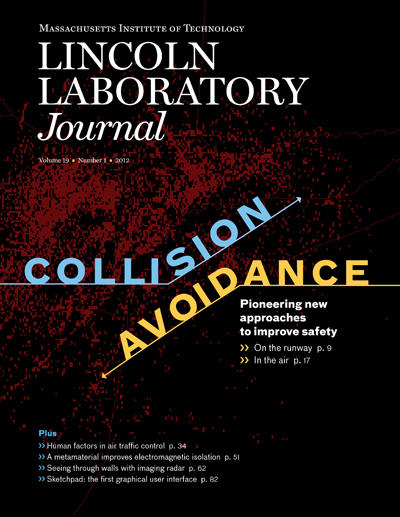Lincoln Laboratory Journal - Volume 19, Number 1

Next-Generation Airborne Collision Avoidance System
Mykel J. Kochenderfer, Jessica E. Holland, and James P. Chryssanthacopoulos
In response to a series of midair collisions involving commercial airliners, Lincoln Laboratory was directed by the Federal Aviation Administration in the 1970s to participate in the development of an onboard collision avoidance system. In its current manifestation, the Traffic Alert and Collision Avoidance System is mandated worldwide on all large aircraft and has significantly improved the safety of air travel, but major changes to the airspace planned over the coming years will require substantial modification to the system. Recently, Lincoln Laboratory has been pioneering the development of a new approach to collision avoidance systems that completely rethinks how such systems are engineered, allowing the system to provide a higher degree of safety without interfering with normal, safe operations.
Human-Systems Integration and Air Traffic Control
Hayley J. Davison Reynolds, Kiran Lokhande, Maria Kuffner, and Sarah Yenson
Data-driven prototype evaluations and benefits analyses that iteratively feed back into the prototype design and development produce a user-friendly system that yields operational benefit. Initial requirements development and field evaluations performed at the Dallas/Fort Worth International Airport Air Traffic Control Tower helped in the design process of the air traffic control Tower Flight Data Manager prototype.
Isolation Improvement with Electromagnetic Band Gap Surfaces
John Sandora
A new type of engineered surface called an electromagnetic band gap blocks current from flowing at microwave frequencies. One application of this metamaterial is to employ the surface amid electronic devices to improve the electromagnetic isolation between them. The different geometry features of the device's individual unit cells create extra inductances and capacitances for electromagnetic waves. When the unit cell is properly tuned, the aggregate surface will block incoming signals just as a band-stop filter will. This additional isolation allows radio-frequency receivers to operate in closer proximity to transmitters than a normal metal surface would permit.
Through-Wall Imaging Radar
John E. Peabody, Jr., Gregory L. Charvat, Justin Goodwin, and Martin Tobias
The ability to locate moving targets inside a building with a sensor situated at a standoff range outside the building would greatly improve situational awareness on the urban battlefield. A radar imaging system was developed to image through walls, providing a down-range versus cross-range image of all moving targets at a video frame rate. This system uses an S-band, frequency-modulated, continuous-wave radar with a spatial frequency range gate coupled to a time-division multiplexed, multiple-input, multiple-output antenna array to rapidly acquire, process, and display radar imagery at a frame rate of 10.8 Hz. Maximum expected range through a 20 cm thick, solid concrete wall is 20 m. Measurements show that this system can locate humans (moving or standing still) behind 10 and 20 cm thick, solid concrete walls and through "cinder-block" walls.
Lab Notes
- All Versus All Conjunctions › Weaving through a minefield of objects in Earth orbit is getting more difficult.
- Nanowire Single-Photon Detector Arrays › Detect a billion photons per second with low noise and high efficiency.
- Runway Status Lights › Protecting aircraft when they are most vulnerable—during takeoff and landing.
- Ultrasensitive Two-Dimensional Photodetection › What information can be associated with the detection of a single photon?
Looking Back
- The TX-2 Computer and Sketchpad › Early computer technology at Lincoln Laboratory led to computer graphics and the functionality of your touchpad